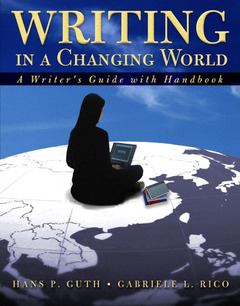Writing in a changing world
Langue : Anglais
Auteurs : GUTH Hans, RICO Gabriele

Preface: To the Instructor. 1. Orientation: To the Student. How Writing Works for You. Writing in a Changing World. Your Progress as a Writer. Computer Writing, Interactive Writing, Collaborative Writing. Writing in a Diverse Society. Assessment and Portfolio Evaluation. Options for Writing l: Your Current Issues Paper. Reading to Writing: Raising the Issues. News Report: Matthew B. Stannard, Threats in Creative School Work Taken Seriously. Sallie Tisdale, Shoe and Tell. Nell Bernstein, Learning to Love. Maurine Shores, A Delayed Reaction to Bigotry. FORUM: Issues in Cyberspace. The Writer's Tools 1: Journals: Getting Ready for Writing. I. A PROGRAM FOR WRITING. 2. Writing and Rewriting: Planning, Drafting, Revising. The Writing Process: An Overview. Discovering Your Purpose. Targeting Your Audience. Searching: Brainstorming, Clustering, Discovery Frames. Pushing Toward a Thesis. Organizing Your Thinking. Writing Your First Draft. Revision: Rewriting and Rethinking. Tracking a Complete Paper. Options for Writing 2: Lining Up Examples. Reading to Writing: Watching the Trend. Fareed Zakaria, The Character of Our Campuses. Richard Rodriguez, Notes from a Changing America. George de Stefano, Ungood Fellas and the Godfather Culture. Dian Judge (Liz Smith), My Breakfast with Fergie. FORUM: Testing, Testing, Testing. The Writer's Tools 2: Priorities for Editing. 3. Resources: Observation and Experience. Drawing on Observation and Experience. Description: The Closer Look. Narration: The Story with a Point. Experience: The Connecting Thread. Finding Your Voice. Revising Your Experience-Based Paper. From Personal to Public Writing. Options for Writing 3: Drawing on Personal Experience. Reading to Writing: Reading Other Lives. Jay Ruben Dayrit, Old Chinese Ladies. Alex Fisher, Tree Hugger. Shaughnessy Bishop-Stall, A Day in the Life of a Lab Rat. Ana Veciana-Suarez, A Place Where We Belong. Amanda Coyne, Mother's Day in Federal Prison. FORUM: From Personal to Political. The Writer's Tools 3: Word Choice: Putting It into Words. 4. Searching: Reading, Internet Search, Interviewing. The Critical Reader. From Reading to Writing. Informal Internet Searches. Drawing on Interviews. Using a Mix of Sources. Revising Your Background Paper. Options for Writing 4: Mobilizing Your Resources. Reading to Writing: The Informed Writer. Tom Abate, Biotech Faces Opposition. * Photos: The Monarch Butterfly Habitat. Environmental Report: Michael Guth, Saving the Monarch Butterflies. Ruth Coniff, The Joy of Women's Sports. * Newspaper Coverage: Women's Sports. Joanna Cagan and Neil deMause, A Tale of Two Cities. FORUM: Enabling the Disabled. The Writer's Tools 4: Sentence Power: Carrying the Message. 5. Comparing/Contrasting: Lining Up Your Data. Writing to Compare. Structuring Your Comparison. Revising Your Comparison/Contrast Paper. Options for Writing 5: Your Comparison/Contrast Paper. Reading to Writing: Thinking About Difference. Jonathan Cohn, Amazon.com: The New and the Old Economy. Kioko Mori, School as an American Opportunity. Jessica Hagedorn, Asian Women in Film: No Joy, No Luck. FORUM: Rethinking Intelligence. The Writer's Tools 5: Mini-Compositions: Writing Paragraphs. 6. STRATEGIES: Process, Classification, Cause and Effect. Tracking a Process. Classification: Testing the Categories. Tracking Cause and Effect. Revising Your Analysis Paper. Options for Writing 6: Your Analysis Paper. Reading to Writing: Sorting Things Out. Marie de Santis, The Last of the Wild Salmon. Kimberly Wozencraft, Coed Prison: Notes from the Country Club. Robert Bly, The Community of Men. William J. Doherty, Private Lives, Public Values. FORUM: The Fencing In of Cyberspace. The Writer's Tools 6: Working Outline to Formal Outline. II. WRITING AND CRITICAL THINKING. 7. Defining: Drawing the Line. Language in a Changing World. Defining Your Key Terms. Writing the Operational Definition. Writing the Extended Definition. Revising Your Definition Paper. Options for Writing 7: Writing to Define. Reading to Writing: Marking Off Boundaries. News story: Zachary Coyle, Senate OKs Campaign Finance Overhaul. Barbara Ehrenreich, The Next Wave. Amoja Three Rivers, Cultural Etiquette: A Guide. *Mural Art, Virginia Declaration of Religious Freedom. Student Essay: Emily Lesk, My 60-Second Protest in the Hallway. FORUM: Bilingualism or English First. The Writer's Tools 7: Writing Plain English. 8. Alternatives: Weighing the Options. Listening to More than One Side. Weighing Opposing Arguments. Structuring Papers Examining Alternatives. Revising Papers Examining Alternatives. Options for Writing 8: Reconciling Alternative Views. Reading to Writing: Hearing the Other Side. James Q. Wilson, In Praise of Asphalt Nation. Andrew Brownstein, A Battle over a Name in the Land of the Sioux. Cynthia Tucker, Black Males Can't Pin Hopes on Athletics. Review: Herbert Kohl, A Case for Considering Race. FORUM: Openly Gay. The Writer's Tools 8: Transitions as Thought Links. 9. Persuading: Changing Minds. Reaching Your Audience. The Strategies of Persuasion. Revising Your Persuasion Paper. Options for Writing 9: Your Persuasion Paper. Reading to Writing: Reaching the Audience. *Full-page ad: Styles Change. Values Don't. Joan Beck, The Government Cannot Protect You. Student Essay: Neema Buruku, Is Television Violence Inflaming Our Youth? Scott Russel Sanders, The Spell of the High Country. Interview: Noam Chomsky, Sports. FORUM: Guns in Our Lives. The Writer's Tools 9: Editing for Inappropriate Language. 10. Arguing: Designing an Argument. Thinking Strategies for Writers. Writing and Thinking Inductively. Writing and Thinking Deductively. Alternative Strategies: Narrowing the Choices. Checking Your Logic. Options for Writing 10: Your Argument Paper. Reading to Writing: Arguing Your Case. Ursula K. Le Guin, The Case against Censorship. Jonathan Kozol, Distancing the Homeless. David Gelernter, What Do Murderers Deserve? Robert Zubrin, Seeing Red. FORUM: Death with Dignity. The Writer's Tools 10: Revising for Logical Fallacies. III. SPECIAL AGENDAS. 11. Workplace English: Writing on the Job. Communicating at Work. Effective Workplace Writing. Reaching the Target Audience. Writ
Date de parution : 08-2003
Ouvrage de 752 p.
© 2024 LAVOISIER S.A.S.



